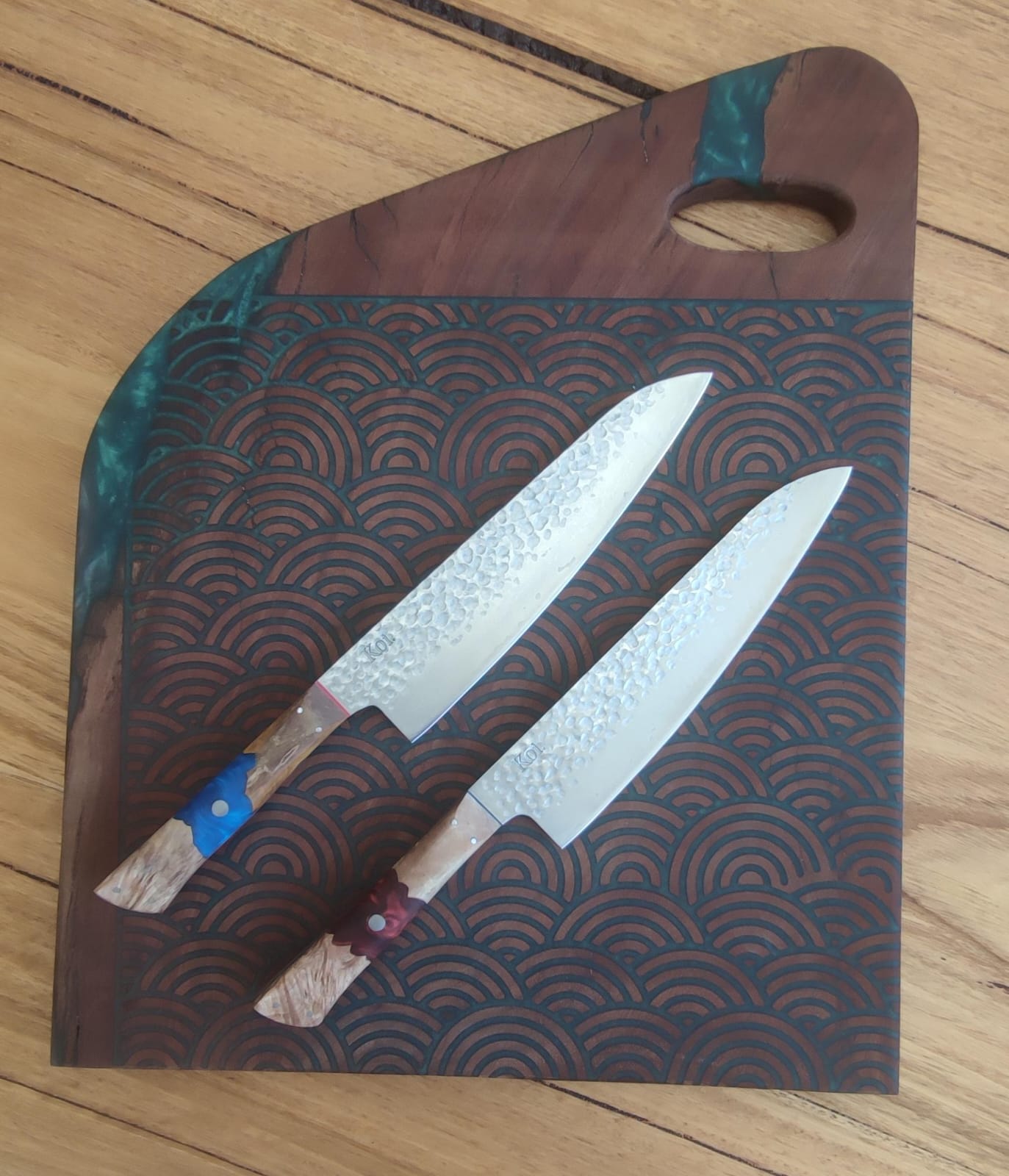Top Five Basic Knife Skills That Every Chef Should Acquire
Without some ironclad knife skills, you might find yourself chopping off your fingers rather than the food and ingredients you are meant to prepare. Good knife skills are also needed for efficiency. If you are nimble with the knife, it is easy to work your way through the ingredients, chopping, cutting and dicing to prepare your delicious meal as quickly as possible.
It is easy enough to have your cooking equipment on the ready, be they the knives, cutting board or pans. But it’s a different ballgame altogether when it comes to using them correctly to get the desired outcome. That require some solid knife skills. Professional chefs no doubt need some advanced knife skills. However, if you’d rather learn some basic knife skills as a home cook or armature chef, we have compiled for you some of the basic knife skills that should get you started on your journey to refining your culinary art.
There is a method to holding the chef’s knives for safe, quick and effective cutting, slicing, dicing or chopping. Keep in mind that how you cut your food can also affect the food flavour and texture. Whether you are an amateur home cook or a professional chef, the last thing you want your cooking to achieve is ruin the flavour and texture of your meal.
Basic knife skills begin with how you hold the knife while cutting different kinds of food. You must also learn how to safely hold the different kinds of foods during the cutting process, be they vegetables, onions, meat or fish.
Your mastery of the knife skills will have some bearing on the quality of the food that you cook. If you have a knife technique, you can always assure uniform cooking at all times. Good knife skills also make your food look good. Just from the looks of it, there is a world of difference between the food that has been cut, sliced or chopped by a professional chef versus that has been worked on by an amateur. Perfection in the knife cuts is a culinary art that you can master with some practice.
#1 Learn How to Hold the Knife Correctly
This is perhaps one of the most basic of the knife skills. Before you begin chopping your food, you have to ensure that you are holding the knife properly. It is recommended that you place your finger and the thumb at the back of the knife while wrapping the other fingers around the knife’s handle. Handling the knife this way will give you more control as well as a firmer grip during the cutting or chopping action.
The hand gripping the knife will be your cutting hand and it should have the star turn. Your other hand will play the supporting function, holding the food you are chopping in place. The role of the supporting hand is to hold, nudge, turn and stabilize the food to enable the cutting hand to achieve the best cuts. At the end of the day, both of your hands should help you achieve maximum safety and efficiency during the cutting action.
Most professional chefs hold the knife by using their palms to choke up on the knife’s handle with their thumb and index fingers gripping the top part of the blade. This is a different knife-holding technique from the one used by home cooks or amateurs.
The typical home cook holds the knife by wrapping the knife’s handle with the whole hand.
The technique used by professional chefs has evolved over the years and is regarded as the most efficient technique for fully taking advantage of the knife’s characteristics including its weight and the sharpness of its blade while combining this with the strength of the chef’s hands to achieve very powerful and easy cuts.
The best way to use your helping hand or supporting hand during the cutting is by deploying it in a bear claw. This refers to a holding technique where your fingertips will curl under as your knuckles press on the ingredient in order to secure it in place and prevent it from their sliding or rolling. Holding your ingredients this way is also relatively safe for your fingers and reduces the possibility of injuries such as the accidental chopping off of your fingers.
An alternative way of holding the food is by bunching your fingertips and then resting the pads on the ingredient you are about to cut.
#2 Chopping
We most readily associate chopping with onions but there is whole bunch of foods that you can chop up such as garlic, cucumbers, carrots, jalapeno, cauliflower, asparagus, bell pepper, lettuces and celery among others.
Chopping shouldn’t be a drudgery if you have mastered your technique well and are efficient with the knife. Professional chefs might make chopping look difficult and intimidating from their knife technique. If you are a home cook, it is usually anything goes as long you get pieces that look almost the same size.
Generally, chopping shouldn’t be a precise culinary art. In fact, even amongst most professional chefs, it is usually a free-form knife skill. The most important thing is to learn how to rapidly chop up the herbs and get on with the cooking. You chop ingredients when you are not looking for a clean slice or dice.
To do a quick chop, roughly pass the knife through your ingredients. You can do this in a rocking motion from the tip of the knife. The chopping knife should be very sharp so as to preserve the flavor in the ingredients. You can chop your ingredients faster by bunching or rolling them together and then chopping these rapidly with minimal cuts. This will enable you to preserve the flavor in the herbs even after chopping.
#3 Dicing
Chopping more or less involves rough and random rocking motion of the knife. Dicing, on the other hand, is a more precise cutting action. In dicing, you slice the fruits and vegetables into small and neat cubes that you can cook uniformly.
The fruits and vegetables, with all their irregular shapes, curves and bumps are diced into small and uniform cubic shapes. You can produce very clean and neat dices by cutting the cubes along the horizontal and vertical lines. Master chefs can produce some of tiniest of dices from the vegetables.
When dicing, your ingredient needs to lie flat on the surface so as to get the neat cuts. If the ingredient is too irregular to sit flat on the surface, you can neatly slice it in half before you dice each of the pieces against your cutting board.
Dice by cutting thin slices in a single direction and then rotating the ingredient and slicing in the other direction. This will give you somewhat perfectly square-shaped dices.
In the case of an onion, you will, of course, begin by peeling it off half down and then cutting out the base of each of the halves of the onion with the top remaining intact. Once you have the onion sitting flat on the surface, make some incisions almost through the entire onion making sure that you leave the pieces attached towards the top. Next, rotate the onion and then slice perpendicularly to the first incisions that you made. This will give you uniform diced pieces of the onion.
When you have mastered the dicing technique, you can now practice dicing ever smaller cubes of different vegetables until you feel comfortable doing this with some relative precision.
#4 Slicing and Cutting
You use your slicing and cutting knife skills when you need to cut ingredients into larger pieces. A perfect example is how you cut tomatoes, cucumbers or lemons. The type of knife used for this purpose along with the knife motions involved in the slicing and cutting depends on the textures of the ingredients you want to cut.
For slicing, you need a very sharp chef’s knife and the cutting should be done in quick downward strokes. That is how professional chefs do it.
Home cooks will often use a serrated knife and cut these veggies in a back-and-forth sawing motion. No matter your preference, the slicing and cutting should be done in such a way that you produce smooth slices that have a uniform thickness.
#5 Chiffonading and Julienning
These long and slim cuts of the ingredients are generally used in salads or stir-fries. The tough greens to be cooked are usually prepared this way. These strips can also be used in preparing fluffy garnishes from either scallions or soft herbs or in raw vegetable patters.
In julienning, the vegetables or other ingredients (usually the tough vegetables) are sliced into very thin pieces which are almost matchstick-like and of uniform sizes. Start by cutting the vegetable into two-inch long segments to get uniform lengths for your eventual julienned pieces. Next, spread these pieces on your cutting board. Holding the knife parallel to the length of the vegetables laid flat on the cutting board, cut them into ultra-thin 1/8-inch slices. Once again, stack these pieces together parallel to the first pieces and repeat. The end result will be ultra-thin matchstick-like pieces that are 2 inches long.
Chiffonading is mostly used with leafy greens to make long, thin and uniform strands of the greens or herbs. These, too, can be mixed into salads or stir-fries. They can also be used as garnishes. To chiffonade, stack together with the leafy greens or herbs into a uniform pile and then roll them together to create a cigar-like shape. Use one of your fingers to secure one end of the rolled bundle and then use a sharp knife to slice through the ‘cigar’ horizontally. This will create very thin ribbon-like strands.




